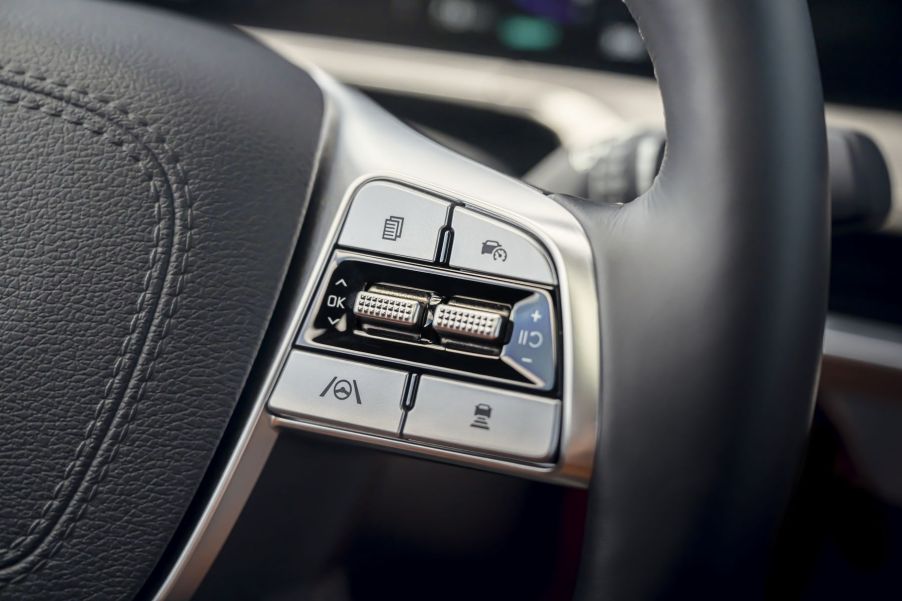
The 4 Automakers With the Best Lane Departure Warning (LDW) Safety System
Modern cars offer many Advanced Car Safety Systems (ACSS) or Advanced Driver Assistance Systems (ADAS), such as Lane Departure Warning (LDW), as standard or optional driver assistance features. However, some automakers integrate these safety features more successfully than others. Here’s a look at the four automakers with the best Lane Departure Warning systems.
- Buick
- Cadillac
- Hyundai
- Jeep
What is Lane Departure Warning?

Lane Departure Warning is a car safety feature intended to help prevent drivers from drifting out of their lane. When the car’s sensors notice that the vehicle has begun to cross over a lane marker without activating the turn signal, it will alert the driver to remain in the correct lane. Depending on the manufacturer, these alerts can be beeps, seat vibrations, or steering wheel vibrations.
Some wonder how LDW differs from a similar-sounding safety feature called Lane Keep Assist (LKA). Lane Keep Assist is designed to adjust your steering automatically when you are about to drift into another lane, while the Lane Departure Warning feature is just that: a warning, which requires the driver to take action on their own.
These four automakers offer the best LDW systems
What manufactures have the best LDW systems–according to their drivers? The winners in this area are Buick, Cadillac, Hyundai, and Jeep.
Buick and Cadillac both implement elements of GM’s Blue Cruise system. With 200,000 pre-mapped miles, Blue Cruise is leading Detroit’s driver-assistance charge. Hyundai, along with Kia and Genesis, has some of the best LDW systems in the industry and excellent LKA systems.
Consumer Reports surveyed vehicle owners on their satisfaction with their LDW system. The publication points out the advantages of LDW systems that allow car owners to select their notification method and the importance of not making these systems overly sensitive. Systems that engage too easily or loudly can annoy drivers and cause them to disconnect the technology, rendering it useless.
How bad can a ba LDW system be? One Toyota Camry owner, frustrated with their over-zealous LDW, said, “I don’t randomly wander around the lanes in the road. If I change lanes it is because I intend to, because there is something blocking my lane of traffic, like a bicyclist.”
Other Advanced Car Safety Systems (ACSS)
Lane Departure Warning is just the tip of the iceberg regarding advanced car safety features that prevent crashes and save lives. Other advanced features designed to enhance safety on the road include Blind Spot Warning (BSW), Rear Cross Traffic Warning (RCTW), and Automatic Emergency Steering (AES).
With Blind Spot Warning, drivers are alerted to the presence of a vehicle in their blind spot if they are in danger of colliding with the other vehicle. More advanced systems can even warn about cars moving into the blind spot before they actually enter it. The most advanced systems can even steer your vehicle away from danger automatically.
Similarly, RCTW can detect traffic and other objects moving toward the sides and rear of your car while you are in reverse, even if they aren’t visible in your backup cam. A warning will alert you to the potential danger, including vehicles, pedestrians, bikers, and more.
Then there’s AES, which, in some cases, can go along with features such as BSW and RCTW. This system automatically steers the vehicle from the danger zone whenever it detects a potential collision. The more advanced systems can decide whether automatic braking or steering makes the most sense in a given situation. They can also warn drivers before applying the automatic steering so that no surprises worsen an already dangerous situation.
All of these advanced safety features are intended to save lives, so many car owners now consider them must-haves in their new vehicles.
Next, find out which automakers have the best lane-keeping assist systems, or learn about all available advanced driver assistance systems in this final video:




